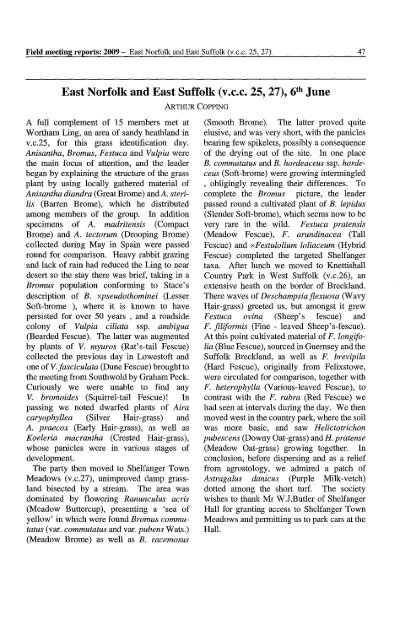BSBINews - BSBI Archive - Botanical Society of the British Isles
BSBINews - BSBI Archive - Botanical Society of the British Isles
BSBINews - BSBI Archive - Botanical Society of the British Isles
You also want an ePaper? Increase the reach of your titles
YUMPU automatically turns print PDFs into web optimized ePapers that Google loves.
Field meeting reports: 2009 - East Norfolk and East Suffolk (v.c.c. 25, 27) 47<br />
East Norfolk and East Suffolk (v.c.c. 25,27), 6 th June<br />
A full complement <strong>of</strong> 15 members met at<br />
Wortham Ling, an area <strong>of</strong> sandy heathland in<br />
v.c.25, for this grass identification day.<br />
Anisantha, Bromus, Festuca and Vulpia were<br />
<strong>the</strong> main focus <strong>of</strong> attention, and <strong>the</strong> leader<br />
began by explaining <strong>the</strong> structure <strong>of</strong> <strong>the</strong> grass<br />
plant by using locally ga<strong>the</strong>red material <strong>of</strong><br />
Anisantha diandra (Great Brome) andA. sterilis<br />
(Barren Brome), which he distributed<br />
among members <strong>of</strong> <strong>the</strong> group. In addition<br />
specimens <strong>of</strong> A. madritensis (Compact<br />
Brome) and A. tectorum (Drooping Brome)<br />
collected during May in Spain were passed<br />
round for comparison. Heavy rabbit grazing<br />
and lack <strong>of</strong> rain had reduced <strong>the</strong> Ling to near<br />
desert so <strong>the</strong> stay <strong>the</strong>re was brief, talcing in a<br />
Bromus population conforming to Stace's<br />
description <strong>of</strong> B. xpseudothominei (Lesser<br />
S<strong>of</strong>t-brome ), where it is known to have<br />
persisted for over 50 years , and a roadside<br />
colony <strong>of</strong> Vulpia ciliata ssp. ambigua<br />
(Bearded Fescue). The latter was augmented<br />
by plants <strong>of</strong> V. myuros (Rat's-tail Fescue)<br />
collected <strong>the</strong> previous day in Lowest<strong>of</strong>t and<br />
one <strong>of</strong> V fasciculata (Dune Fescue) brought to<br />
<strong>the</strong> meeting from Southwold by Graham Peck.<br />
Curiously we were unable to find any<br />
V. bromoides (Squirrel-tail Fescue)! In<br />
passing we noted dwarfed plants <strong>of</strong> Aira<br />
caryophyllea (Silver Hair-grass) and<br />
A. praecox (Early Hair-grass), as well as<br />
Koeleria macrantha (Crested Hair-grass),<br />
whose panicles were in various stages <strong>of</strong><br />
development.<br />
The party <strong>the</strong>n moved to Shelfanger Town<br />
Meadows (v.c.27), unimproved damp grassland<br />
bisected by a stream. The area was<br />
dominated by flowering Ranunculus acris<br />
(Meadow Buttercup), presenting a 'sea <strong>of</strong><br />
yellow' in which were found Bromus commutatus<br />
(var. commutatus and var. pubens Wats.)<br />
(Meadow Brome) as well as B. racemosus<br />
ARTHUR COPPING<br />
(Smooth Brome). The latter proved quite<br />
elusive, and was very short, with <strong>the</strong> panicles<br />
bearing few spikelets, possibly a consequence<br />
<strong>of</strong> <strong>the</strong> drying out <strong>of</strong> <strong>the</strong> site. In one place<br />
B. commutatus and B. hordeaceus ssp. hordeceus<br />
(S<strong>of</strong>t-brome) were growing intermingled<br />
, obligingly revealing <strong>the</strong>ir differences. To<br />
complete <strong>the</strong> Bromus picture, <strong>the</strong> leader<br />
passed round a cultivated plant <strong>of</strong> B. lepidus<br />
(Slender S<strong>of</strong>t-brome), which seems now to be<br />
very rare in <strong>the</strong> wild. Festuca pratensis<br />
(Meadow Fescue), F. arundinacea (Tall<br />
Fescue) and xFestulolium loliaceum (Hybrid<br />
Fescue) completed <strong>the</strong> targeted Shelfanger<br />
taxa. After lunch we moved to Knettishall<br />
Country Park in West Suffolk (v.c.26), an<br />
extensive heath on <strong>the</strong> border <strong>of</strong> Breckland.<br />
There waves <strong>of</strong> Deschampsia flexuosa (Wavy<br />
Hair-grass) greeted us, but amongst it grew<br />
Festuca ovina (Sheep's fescue) and<br />
F. filiformis (Fine - leaved Sheep's-fescue).<br />
At this point cultivated material <strong>of</strong> F. longifolia<br />
(Blue Fescue), sourced in Guernsey and <strong>the</strong><br />
Suffolk Breckland, as well as F. brevipila<br />
(Hard Fescue), originally from Felixstowe,<br />
were circulated for comparison, toge<strong>the</strong>r with<br />
F. heterophylla (Various-leaved Fescue), to<br />
contrast with <strong>the</strong> F. rubra (Red Fescue) we<br />
had seen at intervals during <strong>the</strong> day. We <strong>the</strong>n<br />
moved west in <strong>the</strong> country park, where <strong>the</strong> soil<br />
was more basic, and saw Helictotrichon<br />
pubescens (Downy Oat-grass) and H. pratense<br />
(Meadow Oat-grass) growing toge<strong>the</strong>r. In<br />
conclusion, before dispersing and as a relief<br />
from agrostology, we admired a patch <strong>of</strong><br />
Astragalus danicus (Purple Milk-vetch)<br />
dotted among <strong>the</strong> short turf. The society<br />
wishes to thank Mr WJ.Butler <strong>of</strong> Shelfanger<br />
Hall for granting access to Shelfanger Town<br />
Meadows and permitting us to park cars at <strong>the</strong><br />
Hall.

















